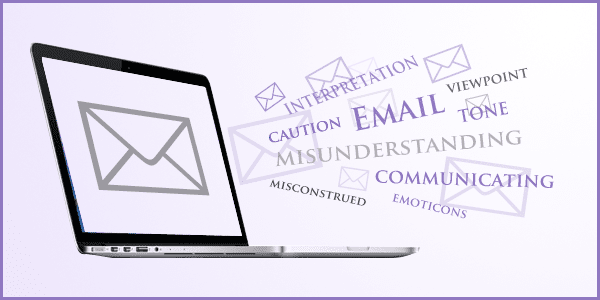Emails – can we communicate as well as we think we can?
Are you trying to be funny? Do you tend to be sarcastic? Or are you deadly serious when sending your emails?
A Journal of Personality and Social Psychology report found that people greatly overestimate their ability to convey their tone over email. The reply you get could be misinterpreted too. They did realise you were only joking …….. didn’t they?
Humans by nature tend to be egocentric, unable to step outside of their own perspectives and be understanding of others. We often believe that most people ‘surely’ think the same way that we do. Which is part of the problem.
Miscommunication is common.
Via any written communication, we cannot hear the tone in someone’s voice, see facial expressions (though we could use an emoticon) or see other cues such as gestures or emphasis. Emails tend to be typed and sent off quicker than a letter, with less thought put into them.
So, should we respond to emails with caution?
Kruger and Epley, cited in the American Psychological Association, compared vocal message interpretation and email message interpretation. They found that over the phone, the intended tone was correctly identified three quarters of the time, but only 56% of the time over email, which is little over half the chance of guessing correctly. Interestingly, when asked whether they thought they had interpreted the message correctly, 90% were confident that they had. Seemingly only 10% of email correspondence interpretation is ever questioned by the receiver.
Kruger explains that when you write an email, you ‘hear’ the tone you are intending to convey, whilst forgetting that the receiver of the email doesn’t have access to such information.
The limitation of email communication may be highly underappreciated and individuals believe that they are communicating more effectively than they actually are.
So, here are our tips for avoiding mis-communication by email. Can you think of any others?
- Positive emails can seem neutral, whilst neutral emails can seem negative. So make sure your emails are extra friendly.
- Take caution when using emoticons to show your feelings, as you can’t counteract what may be seen as a disrespectful email by adding an emoticon. Also, it could come across as unprofessional to a business associate in the workplace.
- Think about the email from the recipient’s viewpoint. Emailers overestimate how effectively they communicate feelings, as do recipients who think they can effectively understand. Jokes are often seen as less funny by the recipient than by the sender.
- Take your time when writing an email, short messages can be interpreted as rude.
- Try not to make them too long either. Say just what needs to be said and then there is less to be misinterpreted.
- Try to get to know the person who you are emailing. Small differences can grow into nuisances, so try to understand your contacts better.
The good news is that as you become more familiar with your email contacts, the chance of your messages being misconstrued is reduced. It’s therefore worth getting to know the people behind the email address!
